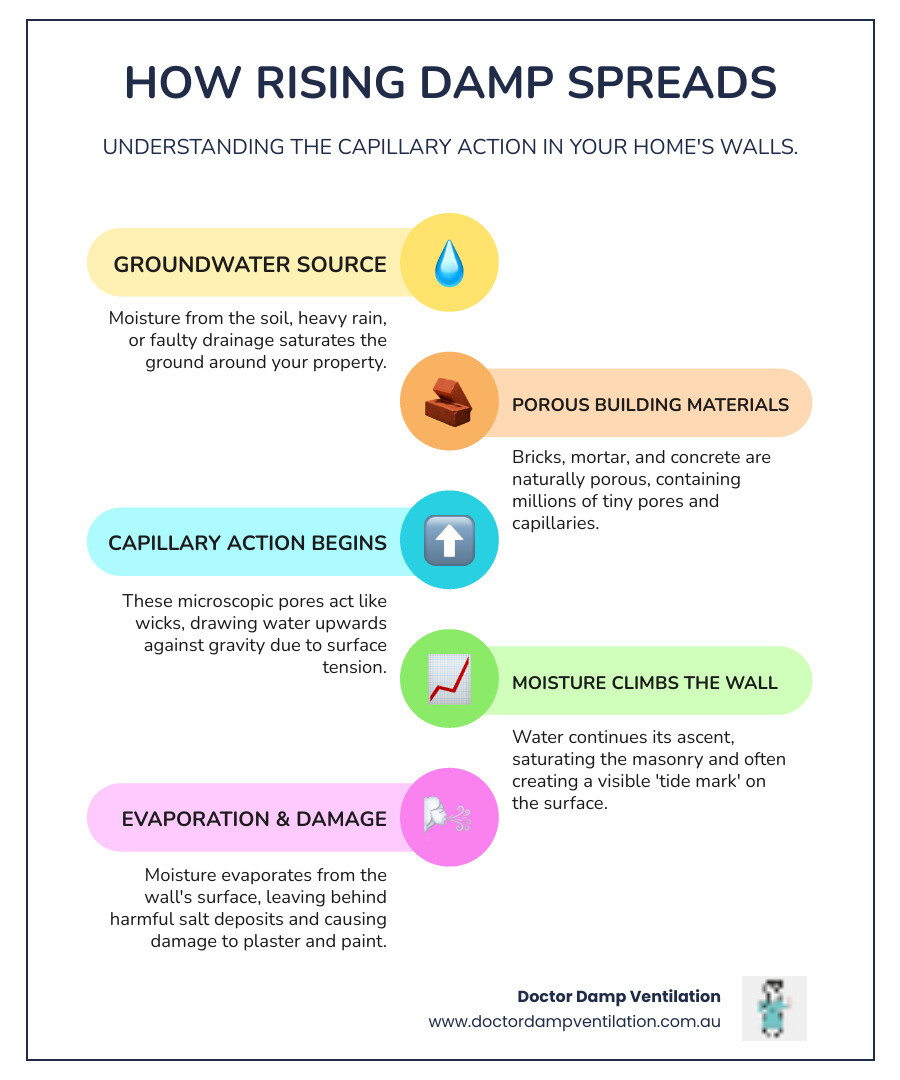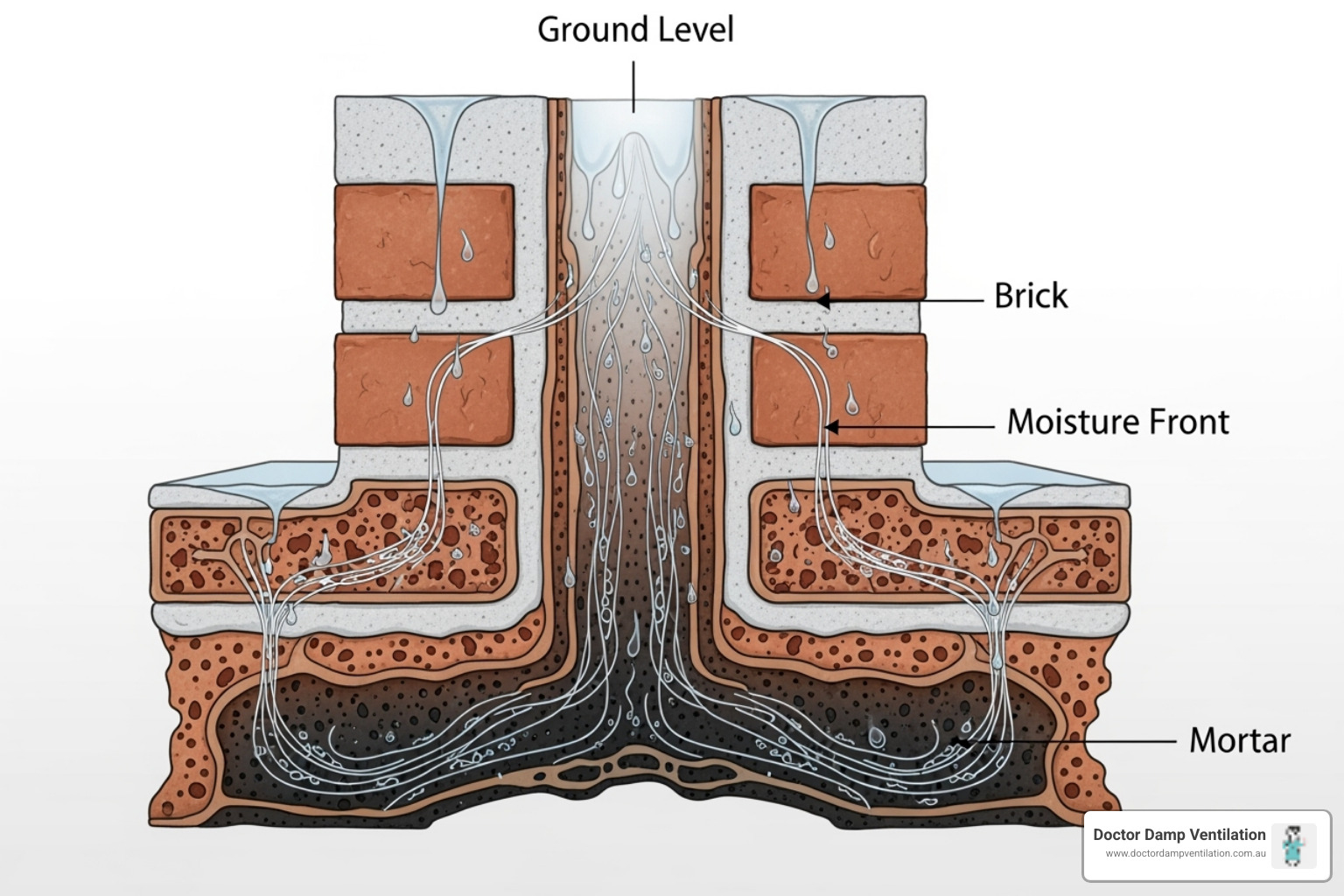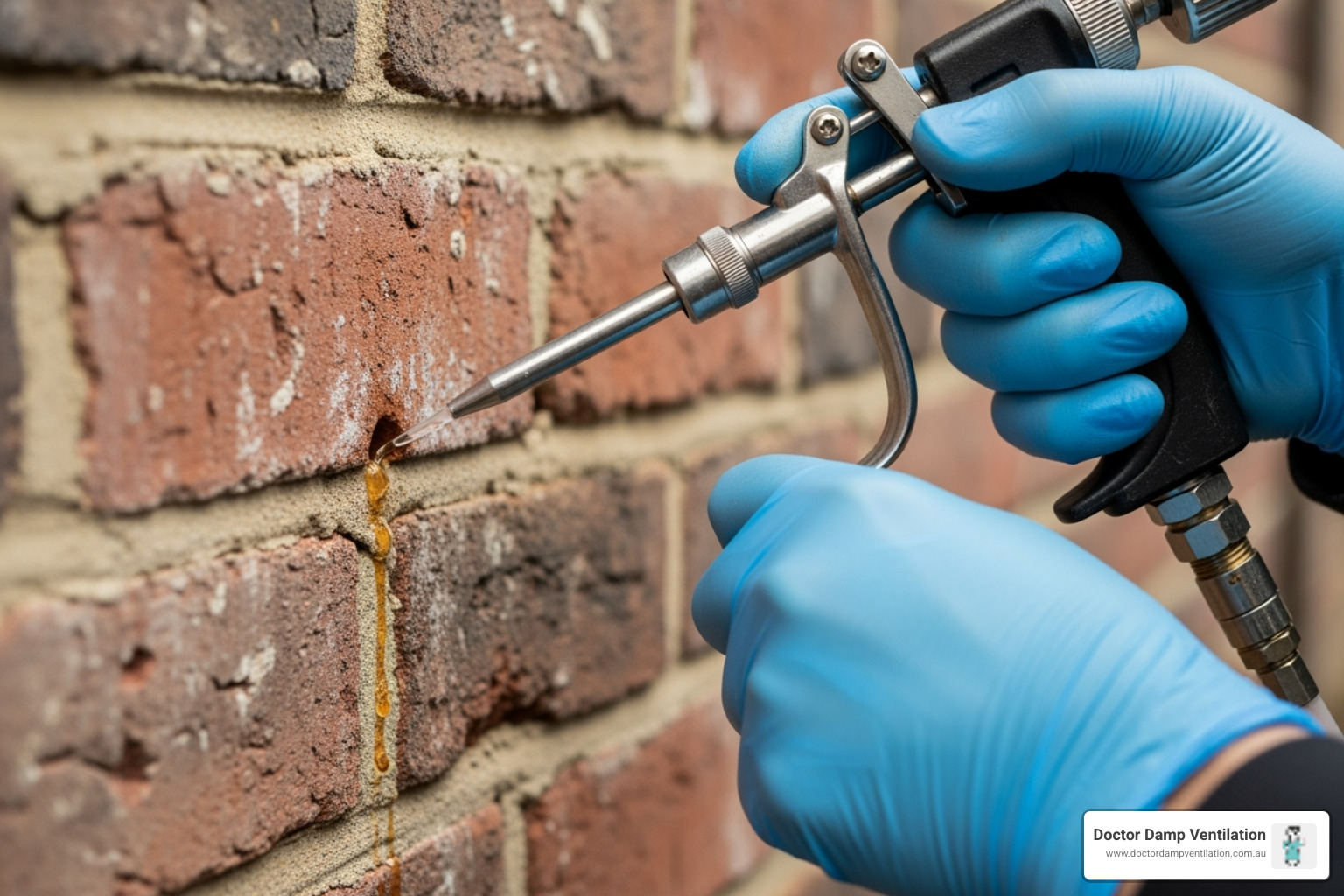Rising Damp Definition 101: Master the Menace
Understanding Rising Damp: Your Essential Guide
Have you noticed a persistent damp patch on your wall, a musty smell, or peeling wallpaper? You might be dealing with rising damp, a specific type of moisture problem that can damage your home and affect your health. In simple terms, rising damp is when groundwater travels up through the porous materials of your walls, like brick and mortar, through a process called capillary action. Key signs include a visible “tide mark” on the wall, crumbling plaster, and white, salty deposits.
This guide will explain what rising damp is, how to identify it, and the most effective ways to treat it, ensuring your Sydney home remains safe and healthy. With over two decades of experience in residential moisture control, I’m Scott Lambert, founder of Dr. Damp, and I’m here to help you understand and solve these complex issues.

Key terms for rising damp definition:
The Science and Reality of Rising Damp
So, what’s the science behind the rising damp definition? It’s a natural process called capillary action. Think of how a paper towel soaks up a spill; the liquid seems to defy gravity as it climbs up the fibres. Your home’s brick and mortar walls act in a similar way. They are porous, containing tiny tubes or capillaries that draw moisture upwards from the ground.
This groundwater isn’t just pure water; it contains dissolved salts. As the water evaporates from the wall’s surface, these salts are left behind, forming a white, powdery deposit. Over many years, this salt accumulation can become significant, causing further damage to plaster and paintwork. This is a key characteristic that helps distinguish rising damp from other moisture problems.
For a deeper technical dive, this Review of Rising Damp in Masonry Buildings offers comprehensive insights.

How High Can Rising Damp Go?
A common question is, “How high can this water travel up my walls?” While theoretically it could go higher, in most homes, rising damp is typically seen up to a height of 1 to 1.5 metres. This is because of a balance between the upward pull of capillary action and the downward force of gravity, combined with evaporation from the wall’s surface.
However, certain factors can cause it to rise higher:
- Poor Ventilation & Impermeable Coverings: Modern paints, vinyl wallpapers, or even dense plaster can trap moisture in the wall. With nowhere to evaporate, the water is forced to climb higher to find an escape route.
- Wall Material: The porosity of your bricks and mortar plays a big role. More porous materials will draw up more water, more quickly.
- Salt Contamination: The salts left behind are hygroscopic, meaning they attract and absorb moisture directly from the air. This can make the wall appear damp even after the source of the rising damp has been fixed, often at heights above the original tide mark.
What Causes Rising Damp in Sydney Homes?
Understanding the rising damp definition is the first step; knowing the cause is key to finding the right solution. While modern homes in areas like Parramatta are built with robust damp-proofing, many of Sydney’s older, character-filled properties in suburbs like Newtown or Paddington are more susceptible. The primary culprit is almost always a problem with the Damp-Proof Course (DPC).

The Role of a Damp-Proof Course (DPC)
A DPC is a waterproof barrier built into the lower part of a wall, usually about 15cm above ground level. Its job is to block moisture from the ground from rising up into the building’s structure. In older homes, this might have been a layer of slate, while modern buildings use materials like polyethylene. When this barrier is missing, damaged, or bridged, there is nothing to stop water from being drawn up into the walls.
Common DPC Problems
Several issues can lead to a DPC failing to protect your home:
- No DPC: Many homes built before the 1900s were constructed without a DPC, leaving them vulnerable from the start.
- Age-Related Failure: Older DPC materials like slate or bitumen can degrade and crack over time, losing their effectiveness.
- Bridging: This is a very common problem. It occurs when the DPC is bypassed. Examples include:
- External Ground Levels: Raising the level of garden beds, paths, or driveways above the DPC line allows moisture to simply go over the top.
- Internal Obstructions: New concrete floors or plaster applied over the DPC inside can create a bridge for moisture to travel up.
- Wall Cavity Debris: Mortar and other building debris left in the wall cavity can accumulate and form a bridge for moisture to cross the DPC, affecting the inner wall.
Identifying the Telltale Signs of Rising Damp
Knowing what to look for is key to catching rising damp early and preventing more extensive and costly damage. While other issues like leaks or condensation can cause dampness, rising damp has a unique set of symptoms. A professional assessment is always best, but you can be your own first line of defence by looking for these signs.

Visual Clues and Hidden Dangers
Look for these common indicators of rising damp, which typically appear on the lower sections of ground-floor walls:
- Tide Marks: A visible stain or discolouration on the wall, often with a distinct line, usually rising up to 1.5 metres from the floor.
- Salt Deposits (Efflorescence): As moisture evaporates, it leaves behind white, fluffy salt crystals on the surface of walls and plaster.
- Damaged Decor: Paint or wallpaper that is blistering, bubbling, or peeling away from the wall.
- Decaying Timber: Skirting boards, floorboards, and floor joists may become damp, discoloured, or start to rot.
- Crumbling Plaster: The presence of salts can cause plaster and mortar to break down and crumble.
- Musty Smell: A persistent damp, earthy odour is a strong sign of an underlying moisture problem.
Beyond the visible damage, untreated rising damp can have serious consequences. It can weaken the structural integrity of your home by causing timber decay (wet and dry rot) and masonry deterioration. Furthermore, the damp environment is a perfect breeding ground for mould, which can release spores into the air and lead to significant health risks, including respiratory problems and allergic reactions. This is why we offer expert Mould Removal services, as outlined by the WHO Guidelines on Dampness and Mould, to ensure your home is safe and healthy.
The Importance of Accurate Diagnosis: Rising Damp vs. Other Moisture Issues
Before any treatment, it’s crucial to correctly identify the source of the damp. Misdiagnosing the problem is a common and costly mistake. Many homeowners in Sydney, from the Inner West to the Northern Beaches, have spent money on ineffective solutions because the true cause of their damp—often condensation or penetrating damp—was mistaken for rising damp. This is why the myth that “rising damp doesn’t exist” persists; it’s not that it’s a myth, but that it’s often misidentified.
A Practical Guide to Differentiating Damp
Understanding the key differences between types of damp is the first step. Here’s a simple comparison:
| Damp Type | Location/Appearance | Common Causes |
|---|---|---|
| Rising Damp | A visible tide mark or stain, often yellowish or brownish, usually up to 1-1.5 metres high on walls. Fluffy white salt deposits (efflorescence). | Failed, missing, or bridged Damp-Proof Course (DPC) allowing ground moisture to be drawn up by capillary action. |
| Condensation | Often appears as black mould spots in corners, on cold surfaces (like windows or tiled walls), and behind furniture. Moisture on windows or mirrors. | High humidity indoors due to poor ventilation, cooking, bathing, drying clothes, leading to water vapour condensing on cold surfaces. |
| Penetrating Damp | Random damp patches that can appear at any height on walls or ceilings. Often worsens during or after heavy rainfall. May show as water stains or damaged plaster. | External defects such as cracked rendering, faulty gutters, leaking pipes, damaged roof tiles, or deteriorated pointing allowing rainwater to penetrate the building. |
Why a Professional Assessment is Non-Negotiable
Guessing the cause of damp is a recipe for wasted time and money. A professional assessment is essential to get to the root of the problem. While a moisture meter can confirm the presence of damp, it can’t distinguish between rising damp, condensation, or a leak. For example, hygroscopic salts left by a previous issue can attract airborne moisture, giving a false reading. A professional survey will include a thorough visual inspection, moisture profiling, and potentially a salt contamination analysis to definitively identify the cause. This ensures the correct remedial action is taken, saving you from unnecessary repairs. If you’re seeing signs of damp, Contact Us for an accurate diagnosis and a custom solution.
What is rising damp and how does it occur?
Rising damp is the process where groundwater is drawn upwards through the porous materials of a building’s walls, such as bricks and mortar. This occurs through a natural phenomenon called capillary action, similar to how a sponge soaks up water. The moisture typically rises from the ground to a height of about 1 to 1.5 metres, where it evaporates, often leaving behind damaging salt deposits.
What are the primary causes of rising damp in buildings?
Rising damp is almost always caused by a failure in the Damp-Proof Course (DPC), a waterproof layer at the base of the wall designed to block moisture. The main causes are:
- No DPC: Many older homes, particularly those in Sydney built before modern building codes, were constructed without one.
- DPC Failure: The original DPC material may have degraded or cracked over time.
- Bridging: The DPC is bypassed when external ground levels (like garden beds or paths) are raised above it, or when internal plaster or screed connects the damp ground to the wall above the DPC.
What are the common signs and symptoms of rising damp?
Look for these key indicators, usually found on the lower parts of ground-floor walls:
- A visible ‘tide mark’ or stain on the wall, typically up to 1.5 metres high.
- Peeling or bubbling paint and wallpaper.
- White, fluffy salt deposits (efflorescence) on the wall surface.
- A persistent musty or damp smell.
- Decaying skirting boards or floor timbers that feel soft or damp.
- Crumbling plaster or mortar joints.
How does rising damp affect a building’s structure and its occupants’ health?
Untreated rising damp can have serious consequences:
- Structural Damage: It can cause timber decay (wet and dry rot) in floor joists and skirting boards, and degrade brickwork and mortar, potentially weakening the building’s structure. It also reduces the thermal insulation of walls, leading to higher energy bills.
- Health Risks: The persistent moisture creates an ideal environment for mould and mildew to grow. These can release spores into the air, triggering allergies, asthma, and other respiratory problems, especially in children and vulnerable individuals. At Doctor Damp Ventilation, we provide non-toxic mould and damp remediation to ensure a safe and healthy home environment for families across Sydney, from Cronulla to Penrith.
Why is accurate diagnosis of rising damp crucial, and what are common misdiagnoses?
Accurate diagnosis is vital because the treatment for rising damp is very different from treatments for other moisture issues like condensation or penetrating damp. Misdiagnosis is common and often leads to ineffective and costly repairs that don’t solve the underlying problem. For example, installing a new damp-proof course won’t fix a leaking pipe or a ventilation issue.
Common misdiagnoses include:
- Condensation: Often mistaken for rising damp, but typically appears as black mould in corners, on ceilings, or behind furniture, especially in poorly ventilated areas like bathrooms and bedrooms.
- Penetrating Damp: Caused by water leaking through the building’s fabric from outside (e.g., faulty gutters, cracked walls). It can appear at any height on a wall and often gets worse after rain.
A professional survey is the only way to be certain of the cause and ensure you get the right solution for your home.
Effective Treatment and Prevention Strategies
Once rising damp has been correctly diagnosed, a combination of treatments is required to solve the problem and prevent its return. This involves stopping the source of the moisture, repairing the damage, and ensuring your home is protected for the future.

Modern Damp-Proofing Solutions
The primary treatment is to install a new, effective damp-proof course (DPC). The most common and reliable method is a chemical DPC injection. This involves drilling holes into the mortar course of the wall and injecting a special cream that penetrates the masonry, creating a permanent waterproof barrier.
Essential Remedial Work
Simply installing a new DPC is not enough. The salts and moisture left in the wall must be addressed:
- Remove Contaminated Plaster: All salt-contaminated plaster must be hacked off to a height well above the damp-affected area.
- Replaster: The wall is then replastered using a salt-resistant render. This prevents any residual salts from migrating to the new surface and causing further damage.
- Allow to Dry: The wall needs adequate time to dry out completely before redecorating.
Long-Term Prevention
To prevent future issues, it’s important to manage moisture around your property:
- Improve Drainage: Ensure ground levels and pathways slope away from your house.
- Check for DPC Bridging: Make sure soil, garden beds, or new patios are not built up against the wall above the DPC line.
- Ensure Sub-Floor Ventilation: Good airflow under suspended floors is crucial for keeping the sub-floor area dry. We provide expert Sub-Floor Ventilation solutions for this purpose.
- Maintain Gutters: Keep gutters and downpipes clear of debris to prevent water from overflowing against the walls.
By taking these steps, you can create a dry and Healthy Home environment.
Frequently Asked Questions about Rising Damp
Is rising damp a myth?
No, rising damp is a real and scientifically understood phenomenon. The myth often arises from misdiagnosis, where other damp issues like condensation or leaks are incorrectly identified as rising damp. When the wrong treatment is applied, it fails, leading people to believe rising damp isn’t real. A professional diagnosis is key to identifying genuine cases.
Can I treat rising damp myself?
While DIY kits are available, we strongly advise against it. Effective treatment requires specialised equipment for injecting a new damp-proof course and expert knowledge to correctly remove salt-contaminated plaster and apply a new render. Incorrect application can lead to the problem returning, costing more in the long run.
Does rising damp have a distinct smell?
Yes, rising damp often produces a persistent musty or earthy smell. This odour is caused by the moisture itself and the growth of mould and mildew within the damp wall materials. While other damp problems can cause similar smells, it’s a clear indicator that you have a moisture issue that needs investigating.
Conclusion
Understanding the rising damp definition—the upward movement of groundwater through your walls—is the first step to protecting your property. Caused by a failed or non-existent Damp-Proof Course (DPC), it’s identified by tell-tale signs like tide marks and salt deposits, and can lead to serious structural and health issues if left untreated.
Accurate diagnosis is crucial to differentiate it from other forms of dampness like condensation or penetrating damp. Effective treatment involves installing a new DPC, removing contaminated plaster, and ensuring proper ventilation and drainage around your home.
At Doctor Damp Ventilation, we specialize in providing expert, non-toxic, and guaranteed solutions for homes across Sydney, from the Eastern Suburbs to the Greater West. If you suspect you have a damp problem, don’t wait for it to get worse. Protect your home and your family’s health by addressing Rising Damp with professional care.

